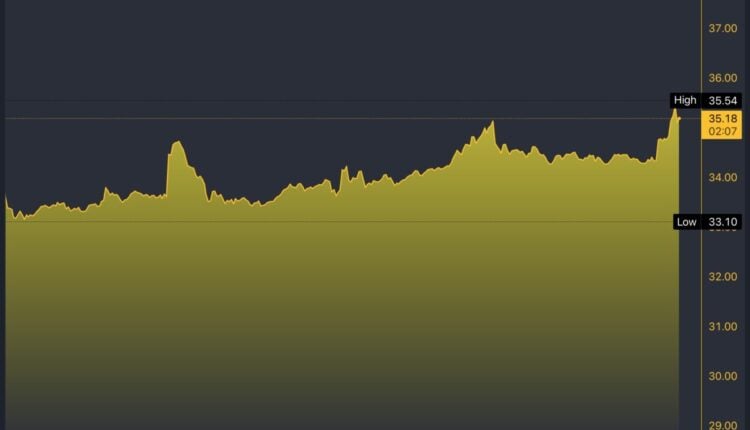
Bitcoin Must Break $62K Resistance to Prevent Market Crash
Bitcoin has been moving toward its lowest point since May 2. Various factors contributed to selling pressure that affected the leading digital asset. Over the past day, BTC/USD remained steady, trading at $60,871 (£48,122) on Thursday.
The top cryptocurrency by market value has dropped over 10% in August. However, the coin’s yearly substantial ratio remains on the gains side. Overall, Bitcoin’s value increased by about 100% throughout the period.
On the other side, it remains down more than 17% from its peak of $73,798 in mid-March. Simultaneously, other digital assets like Ether (ETH/USD) and Solana (SOL/USD) have declined by 0.6% and 0.2% within the last 24 hours, respectively.
Moreover, Bitcoin has not aligned with the strength of this week’s global stock market. The S&P 500 (^GSPC) and Nasdaq Composite (^IXIC) both ended Wednesday’s trading session on a positive note.
Multiple factors have contributed to the rising selling pressure. Among others, the Mt Gox trustee announced that repayments to the creditors of the defunct exchange will start in July.
A total of approximately 142,000 BTC, valued at nearly $9 billion, will be distributed among creditors. Investors remain cautious. There is a sense of fear that Mt Gox creditors might offload their newly received BTC on exchanges. Such an anxious anticipation of the outcome is no surprise. These creditors have waited over a decade for their repayment.
United States and Germany: Authorities Transfer BTC to Exchanges
Yet another sell pressure factor arises as Arkham Intelligence reports the US government recently transferred 3,940 BTC to Coinbase. This BTC, seized from convicted drug dealer Banmeet Singh earlier in 2024, has contributed to market pressure.
In January, the court ordered Singh to forfeit over 8,100 BTC to US authorities as part of his sentencing. The US Drug Enforcement Agency described this BTC seizure as the largest in its history.
Additionally, an analysis by Arkham Intelligence revealed on Tuesday that the German government recently moved $24 million in seized bitcoin to the Kraken and Coinbase cryptocurrency exchanges.
These BTC transfers came from a wallet associated with the German Federal Criminal Police Office (BKA). They might be connected to the BKA’s 2013 seizure of nearly 50,000 BTC from a film piracy site.
Arkham Intelligence reports show that these transfers follow a previous movement of $195 million in bitcoin to exchanges last week. The BKA-associated wallet has moved over $425 million in BTC in the past week.
These transfers might suggest a plan to sell some of the assets, which could further depress the value of the digital currency.
Demand for Spot Bitcoin ETFs Increases
While various factors contribute to selling pressure, institutional interest in US-based spot bitcoin exchange-traded funds (ETFs) is beginning to rise after a period of reduced interest.
On Wednesday, spot BTC ETFs experienced net inflows of $21.52 million. Thereby continuing the upward trend that started on Tuesday.
On the same day, Fidelity’s FBTC led the spot bitcoin ETFs with the highest net inflows, attracting $19 million. This performance underscores the fund’s growing popularity among investors.
US spot Bitcoin exchange-traded funds (ETFs) marked their sixth consecutive day of positive performance on Thursday. These funds collectively attracted around $65 million. BlackRock’s iShares Bitcoin Trust (IBIT) led the way, drawing approximately $75 million in new capital.
Grayscale’s GBTC experienced net inflows of $4 million. Reaching this milestone marked its first positive movement since June 5. Similarly, VanEck also saw $3 million in inflows that day.
For instance, Grayscale’s Bitcoin Trust (GBTC) has the highest management fees among US spot Bitcoin products. However, it still faced over $28 million in outflows on Thursday. Since its conversion into an ETF, investors have pulled nearly $20 billion from GBTC.
Nevertheless, the significant outflows have eased in the past two weeks. The previous day, GBTC’s withdrawals fell to just under $10 million. This financial point has underlined the lowest outflow of the month.
Currently, GBTC’s outflows have slowed, and other Bitcoin ETFs, particularly BlackRock’s IBIT, continue to attract investments. Meanwhile, US spot Bitcoin funds have seen consistent inflows for six straight trading days. This week, these ETFs have accumulated more than $250 million in net inflows.

IBIT/USD 5-Day Chart
Markets Dive as Japan Faces ‘Black Monday’
On Monday, Japan’s Nikkei 225 (^N225) experienced its worst daily decline ever. Panic selling, fueled by fears of a potential US recession, spread to European markets and caused the drop.
By the close of trading in Tokyo, the index had plummeted by 4,451.28 points, or 12.40%. It ended the day at 31,458.52.
This drop marks the largest point decline ever recorded, surpassing the decrease on October 20, 1987, which followed New York’s Black Monday. In terms of percentage, it stands as the second-largest decline according to Nikkei data.
But what does ‘Black Monday’ even mean? To figure that out, we need to go back in time.
On October 19, 1987, known as Black Monday, a wave of market turmoil caused global stock exchanges to crash within hours, largely due to computer-driven trading strategies that accelerated the sell-off.
In the US, the Dow Jones Industrial Average (^DJI) dropped 22.6% in just one trading day, marking the largest single-day decline in stock market history. This event also represented the steepest market drop in the US since the Great Depression.
In response, the Federal Reserve had to intervene by cutting interest rates and offering liquidity support to stabilise the markets.
This time, the sell-off spread throughout Asia, impacting markets in Singapore (^STI), Indonesia (^JKSE), Thailand (^SET.BK), and the Philippines (PSEI.PS), each falling between 2% and 3%.
Japanese Finance Minister Shunichi Suzuki voiced “grave concern” as the government keeps a close watch on the market developments.
FTSE Stands Out: Recession Fears Subside
While global markets have been recovering since last week’s ‘Black Monday,’ stocks fell sharply due to concerns about a US recession.
Recent rebounds in the markets have followed stronger-than-expected US retail sales and unemployment data, easing recession fears.
The S&P 500 and Nasdaq have remained stable throughout August. Later rebounding from their three-month lows last week. Currently, the S&P 500 is up 17% and the Nasdaq is up 19%. The Nikkei 225 increased by 3.6% today. Simultaneously, the S&P 500 gained 1.6% in pre-market trading.
The UK markets are the notable exception today. The FTSE 100 and FTSE 250 have both decreased by 0.5% and 0.3%, respectively. This decline is largely attributed to disappointing retail sales figures for July. Despite this, both UK indices have still recovered from their dip on August 5.
AJ Bell’s investment director, Russ Mould, observed that the abrupt market disruption at the start of August now appears to be a distant memory.
Global indices have been regaining lost ground, and the VIX volatility index has reverted to the levels typical over the past year.
Mould highlighted that stronger-than-anticipated US retail sales and robust earnings from Walmart have alleviated apprehensions regarding a potential recession in the US.
Markets have stabilised as expectations shift regarding the Federal Reserve’s potential interest rate cut in September. Initially, the likelihood of a significant 0.5 percent reduction was as high as 85 percent last Monday. However, it has since decreased to 25 percent, according to CME Group data.
Similarly, forecasts for US interest rates by year-end have changed. The market now anticipates a smaller reduction, with expectations adjusted to reflect about 0.25 percent less by December.
Fears of Recession Trigger a Global Market Selloff Again
Tan Boon Heng, an economist from Mizuho Bank in Singapore, expressed concern about a potential scenario. He thinks that rising unemployment limits consumer spending. In turn, it would further restrict hiring, incomes, and overall economic activity, potentially leading to a recession.
Disappointing jobs and manufacturing data from the US have raised concerns. There is worry that the Federal Reserve may have delayed cutting interest rates for too long. This delay could potentially harm the world’s largest economy.
On Wednesday, the US Federal Reserve decided to maintain interest rates in the 5.25% to 5.5% range. This rate has remained unchanged since July of the previous year.
Kyle Rodda, a senior financial market analyst at Capital.com, commented on the current market situation. He noted that markets are experiencing a significant downturn, with widespread declines across the globe.
The primary issue is a potential slowdown in the US economy, which has led to growing concerns about global economic growth.
The market downturn has spread across various financial sectors. US Treasury yields have continued to decline, European stock indexes have turned negative, Bitcoin has faced substantial sell-offs, and the dollar has weakened, particularly against the yen.
As panic selling intensifies, traders are increasingly speculating on imminent interest rate reductions. Current money market data indicates an 83% likelihood of a 0.5% rate cut by the US Federal Reserve in September, with the potential for an additional cut in November.
Therefore, investors are looking for solutions. So far, there are some options available. Let’s dissect!
How to Avoid a Major Decline? Surpassing $62K Might Help
With the latest dynamics in mind, it is crucial to determine the future trajectory of BTC. Analysts from Kraken warn that Bitcoin must reach and maintain $62,000 to prevent a decline below $50,000. However, some traders are more optimistic.
According to a recent analyst note, Bitcoin is at a crucial juncture. It needs to hit $62,000 and stay there to avoid falling back to $49,000. Despite this, many crypto traders believe a drop below $50,000 is unlikely in the near future.
Kraken’s crypto market update from August 21 suggests that the current price action indicates a corrective pattern rather than a strong bullish trend.
As of the latest update, Bitcoin is trading at $60,691 and has not touched $62,000 since August 9, 2024.
Besides, Kraken noted that Bitcoin is currently trading close to its 200-day exponential moving average of $59,500, which prioritises recent price data.
To prevent a drop to $49,000, Bitcoin must surpass the $62,000 resistance level.
Bitcoin last fell below $50,000, reaching $49,842 on August 5, an event dubbed “Crypto Black Monday,” marking its first return to that level since February.
Achieving $62,000 would surprise many future traders, potentially liquidating $1.04 billion in short positions, as reported by CoinGlass.
As Bitcoin hovers near critical price points, the market remains poised between potential breakthrough and pullback, with analysts and traders closely watching key resistance levels that could determine the cryptocurrency’s short-term trajectory.
The post Bitcoin Must Break $62K to Prevent Another ‘Black Monday’ appeared first on FinanceBrokerage.
